A Rainbow of Fancy Colored Diamonds
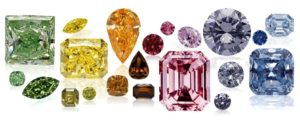 In diamonds, rarity equals value. With fancy color diamonds—the ones outside the normal color range—the rarest and most valuable colors are saturated pinks, blues, and greens. In all cases, even very slight color differences can have a big impact on value.
In diamonds, rarity equals value. With fancy color diamonds—the ones outside the normal color range—the rarest and most valuable colors are saturated pinks, blues, and greens. In all cases, even very slight color differences can have a big impact on value.
Compared to fancy yellows and browns, diamonds with a noticeable hint of any other hue are considerably more rare. Even in light tones and weak saturation, as long as they show color in the face-up position, they qualify as fancy colors. Red, green, and blue diamonds with medium to dark tones and moderate saturations are extremely rare.
Grading fancy color diamonds is complex and specialized, and it takes highly trained laboratory graders to complete the process accurately. The GIA system for color-grading fancy color diamonds is designed to accommodate the fact that not all colored diamonds have the same depth of color. For example, yellow diamonds occur in a wide range of saturations, while blue diamonds do not.
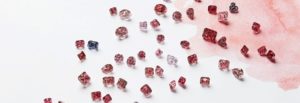
Argyle 2017 Pink Diamond Tender
Diamonds with red or reddish colors are extremely rare and highly valued. Pure pinks are more popular than diamonds that are purplish, orangy, brownish, or grayish. Trade professionals market some very attractive stones in this category as “rose-colored,” and some stones with purplish tints as “mauve” diamonds.
Blue diamonds are extremely rare. They generally have a slight hint of gray, so they’re rarely as highly saturated as blue sapphires. Their color is caused by the presence of boron impurities—the more boron, the deeper the blue.
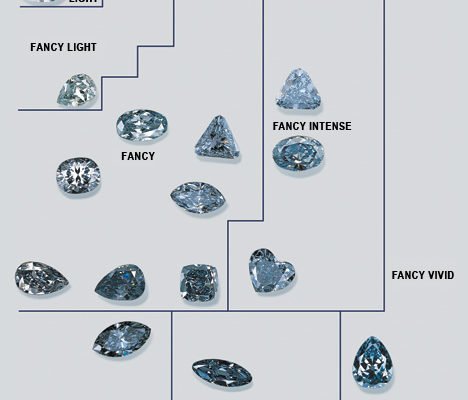
Fancy Blue Diamond Saturation Chart, courtesy of GIA
Fancy green diamonds are typically light in tone and low in saturation. Their color often appears muted, with a grayish or brownish cast. The hue is generally in the yellowish green category. In most green diamonds, the hue is confined to the surface, and rarely extends through the entire stone. That’s why cutters try to leave as much of the natural rough around the girdle as possible.
Naturally colored green diamonds are extremely rare. Because of their rarity and the very real possibility of treatment, green diamonds are always regarded with suspicion and examined carefully in gemological laboratories. Even so, advanced gemological testing can’t always determine color origin in green diamonds.
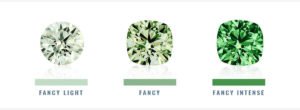
Pure green diamonds are preferred, but most of the stones contain secondary colors.
Brown is the most common fancy diamond color and the earliest to be used in jewelry. Second-century Romans set brown diamonds in rings. In modern times, however, they took some time to become popular. Brown diamonds were typically considered good only for industrial use until the 1980s, when abundant quantities of them began to appear in the production of the Argyle mines. The Australians fashioned them and set them in jewelry. They gave them names like “cognac” and “champagne.” The marketing worked, and brown diamonds are found in many medium-priced jewelry designs today.
Yellow is diamond’s second most common fancy color. Yellow diamonds are sometimes marketed as “canary.” While this isn’t a proper grading term, it’s commonly used in the trade to describe fancy yellow diamonds.
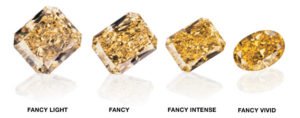
Fancy color diamonds have a range of color strength with the intense and vivid colored diamonds being the most rare.
Until the late 1990s, there was not much demand for black diamonds. But designers started using them in jewelry, especially contrasted with tiny colorless diamonds in pavé settings, and they began to gain in popularity. Fancy white diamonds also exist. They have a milky white color. Sometimes white diamonds are cut to display beautiful opalescent flashes of color.
Color-Treated Diamonds
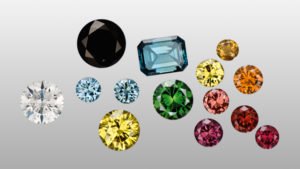
Colorless and other diamonds (left) can be artificially irradiated causing a variety of colors. Some of the irradiated colors are then heated as a second step, resulting in additional colors (group right).
Many of the colored diamonds that are found in jewelry are color-treated, meaning that undesirable colored diamonds have been treated to enhance their color. There are a few different treatments that make this happen. The most common is High Pressure High Temperature (HPHT) where the stone is put under those conditions to change the color. There is also a procedure called Irradiation, where the diamonds are exposed to high energy electron or neutron particles which physically alter the crystal lattice. Lastly there are synthetic colored diamonds which are lab grown diamonds that are created under the types of conditions that natural colored diamonds would be exposed to.
All these different treatments significantly decrease the value of the colored diamond, which is why you only want to buy a colored diamond from a seller who will provide a grading report from a trusted lab such as GIA.





